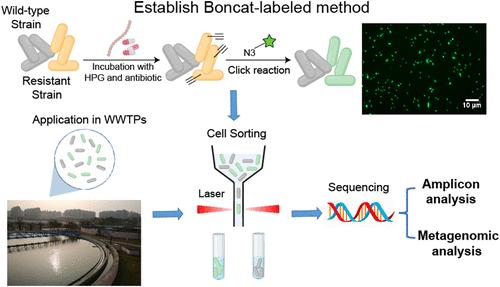当前位置:
X-MOL 学术
›
Environ. Sci. Technol.
›
论文详情
Our official English website, www.x-mol.net, welcomes your
feedback! (Note: you will need to create a separate account there.)
High-Throughput Single-Cell Metabolic Labeling, Sorting, and Sequencing of Active Antibiotic-Resistant Bacteria in the Environment
Environmental Science & Technology ( IF 10.8 ) Pub Date : 2024-09-27 , DOI: 10.1021/acs.est.4c02906 Wenfang Lin, Ruilong Li, Shaoheng Cao, Hongzhe Li, Kai Yang, Zhugen Yang, Jianqiang Su, Yong-Guan Zhu, Li Cui
Environmental Science & Technology ( IF 10.8 ) Pub Date : 2024-09-27 , DOI: 10.1021/acs.est.4c02906 Wenfang Lin, Ruilong Li, Shaoheng Cao, Hongzhe Li, Kai Yang, Zhugen Yang, Jianqiang Su, Yong-Guan Zhu, Li Cui

|
Active antibiotic-resistant bacteria (ARB) play a major role in spreading antimicrobial resistance (AMR) in the environment; however, they have remained largely unexplored. Herein, we coupled bio-orthogonal noncanonical amino acid tagging with high-throughput fluorescence-activated single-cell sorting (FACS) and sequencing to characterize the phenome and genome of active ARB in complex environmental matrices. Active ARB, conferring resistance to six antibiotics throughout wastewater treatment, were distinguished and quantified. The percentage and concentration of active ARB ranged from 0.28% to 45.3% and from 1.1 × 104 to 2.09 × 107 cells/mL, respectively. Notably, the final effluents retained up to 4.79 × 104 cells/mL of active ARB. Targeted FACS and genomic sequencing revealed a distinct taxonomic composition of active ARB compared with that of the overall population. The coexistence of antibiotic resistome and mobilome in active ARB was also identified, including three high-quality metagenomic assembly genomes assigned to pathogenic bacteria, highlighting the substantial health risks due to their activity, phenotypic resistance, mobility, and pathogenicity. This study advances our understanding of previously overlooked active ARB in the environment by linking their resistance phenotype to their genotype. This high-throughput method will enable efficient quantitative surveillance of active AMR, providing valuable insights into risk control and management.
中文翻译:

环境中活性抗生素耐药细菌的高通量单细胞代谢标记、分选和测序
活性抗生素耐药细菌(ARB)在环境中传播抗生素耐药性(AMR)方面发挥着重要作用;然而,它们在很大程度上仍未被探索。在此,我们将生物正交非规范氨基酸标记与高通量荧光激活单细胞分选(FACS)和测序结合起来,以表征复杂环境基质中活性 ARB 的表型和基因组。活性 ARB 在整个废水处理过程中赋予六种抗生素耐药性,并进行了区分和量化。活性ARB的百分比和浓度范围分别为0.28%至45.3%和1.1×10 4至2.09×10 7 个细胞/mL。值得注意的是,最终流出物保留了高达 4.79 × 10 4 个细胞/mL 的活性 ARB。靶向 FACS 和基因组测序揭示了活性 ARB 与总体群体相比具有独特的分类组成。还确定了活性 ARB 中抗生素抗性组和移动组的共存,包括分配给致病菌的三个高质量宏基因组组装基因组,强调了其活性、表型抗性、移动性和致病性造成的重大健康风险。这项研究通过将其耐药表型与其基因型联系起来,增进了我们对环境中以前被忽视的活性 ARB 的理解。这种高通量方法将能够对主动 AMR 进行有效的定量监测,为风险控制和管理提供有价值的见解。
更新日期:2024-09-29
中文翻译:

环境中活性抗生素耐药细菌的高通量单细胞代谢标记、分选和测序
活性抗生素耐药细菌(ARB)在环境中传播抗生素耐药性(AMR)方面发挥着重要作用;然而,它们在很大程度上仍未被探索。在此,我们将生物正交非规范氨基酸标记与高通量荧光激活单细胞分选(FACS)和测序结合起来,以表征复杂环境基质中活性 ARB 的表型和基因组。活性 ARB 在整个废水处理过程中赋予六种抗生素耐药性,并进行了区分和量化。活性ARB的百分比和浓度范围分别为0.28%至45.3%和1.1×10 4至2.09×10 7 个细胞/mL。值得注意的是,最终流出物保留了高达 4.79 × 10 4 个细胞/mL 的活性 ARB。靶向 FACS 和基因组测序揭示了活性 ARB 与总体群体相比具有独特的分类组成。还确定了活性 ARB 中抗生素抗性组和移动组的共存,包括分配给致病菌的三个高质量宏基因组组装基因组,强调了其活性、表型抗性、移动性和致病性造成的重大健康风险。这项研究通过将其耐药表型与其基因型联系起来,增进了我们对环境中以前被忽视的活性 ARB 的理解。这种高通量方法将能够对主动 AMR 进行有效的定量监测,为风险控制和管理提供有价值的见解。











































 京公网安备 11010802027423号
京公网安备 11010802027423号